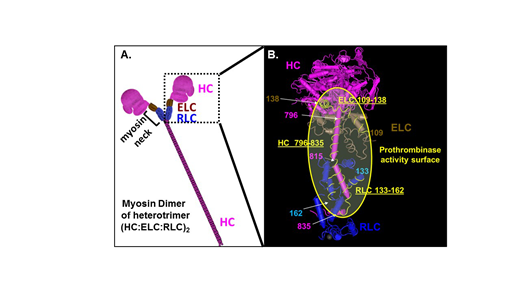Skeletal muscle myosin (SkM) is a muscle protein consisting of a dimer of heterotrimers, each trimer comprising a regulatory light chain (RLC), an essential light chain (ELC), and a heavy chain (HC). Recently it was discovered that SkM has potent procoagulant and prothrombotic activity (Deguchi H, et al, Blood. 2016;128:1870-1878). Mechanistic studies showed that SkM's potent prothrombotic activity involved enhancing thrombin generation due to SkM's ability to bind coagulation factors Xa and Va which accelerates prothrombin activation. However, detailed molecular mechanisms for SkM's binding of these coagulation factors have not been described.
Since a well-known myosin inhibitor, trifluoperazine (TFP), inhibited SkM's procoagulant activity and since this inhibitor binds to the ELC in SkM's "neck" region which connects the HC head region to the HC tail (Figure, panel A), we hypothesized that SkM's TFP binding region on the ELC in the neck region directly contributes to SkM's procoagulant activity. To identify potential binding site(s) on SkM for factors Xa and Va, 22 peptides representing the neck region's RLC, ELC, and HC were screened for inhibition of SkM-supported prothrombin activation by purified factor Xa, factor Va, and calcium ions. These peptides contained 25-40 residues and overlapped by approximately 5-10 amino acids. Peptides ELC109-138 and ELC129-159, corresponding to amino acid residues 109-138 and 129-159 of the ELC, inhibited SkM-supported prothrombin activation at 100 μM, whereas their partially overlapping neighboring peptides, ELC99-122 and ELC149-173, did not. Three HC peptides (peptides HC781-810, HC796-835, HC815-854) and one RLC peptide (RLC133-162) inhibited SkM-supported prothrombin activation at 100 μM, and each was also inhibitory, to varying degrees, when assayed at 5 μM. Dose-dependency inhibition assays gave IC50 values (50% inhibition of activity) for the peptides HC781-810, HC796-835, HC815-854, and RLC133-162 of 64, 1.2, 2.3 and 26 μM. Peptides HC781-810 and HC815-854 also inhibited prothrombin activation in the absence of myosin but in the presence of phospholipid vesicles containing 20 % phosphatidylserine (IC50 = 7.5 and 104 μM, respectively). In contrast, the strong inhibitory effects of peptides HC796-835, RLC133-162, ELC109-138 and ELC129-159 seen in the presence of myosin were not at all apparent in the presence of phospholipid-supported prothrombin activation when myosin was absent. This suggests that peptides HC796-835, RLC133-162, ELC109-138 and ELC129-159 specifically inhibit SkM-supported prothrombin activation. The 19 synthetic peptides representing the SkM neck region were also screened at 25 µM (final) for their inhibition of recalcification-induced thrombin generation in human plasma which contains significant circulating levels of SkM. Among the 19 peptides tested, HC796-835 and HC815-854 significantly inhibited thrombin generation when screened at 25 µM in plasma.
Immobilized peptide HC796-835 showed direct binding of purified factor Xa with apparent Kd of 1.4 μM. This very potent inhibitory peptide, HC796-835, exhibited 50% inhibition of SkM-enhanced prothrombin activation at 1.2 μM, indicating that this peptide's sequence provides a factor Xa binding site on SkM which contributes to its inhibitory action. More specifically, an overlapping peptide containing amino acid residues 815-835 inhibited SkM-enhanced prothrombin activation by factors Xa and Va while a peptide comprising residues 796-811 did not. These studies suggest that residues 815-835 of SkM's HC are responsible for directly binding factor Xa and implies that this binding is responsible for SkM's procoagulant activity (Figure, panel B).
In summary, we identified human SkM peptides which specifically blocked SkM-enhanced thrombin generation but not phospholipid-stimulated prothrombin activation in purified reaction mixtures and which inhibited blood clotting in plasma. The most potent anticoagulant HC peptide also directly binds purified factor Xa. These findings strongly suggest that the neck region of SkM, as defined by these inhibitory peptides (Figure, panel B), provides a phospholipid-independent procoagulant surface for thrombin generation that, depending on the in vivo physiologic context, may contribute to either hemostasis or thrombosis.
No relevant conflicts of interest to declare.
Author notes
Asterisk with author names denotes non-ASH members.


